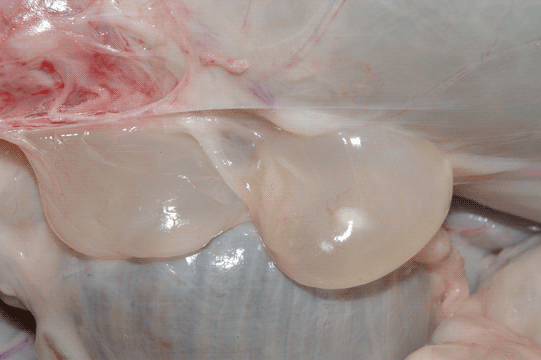Crossref Citations
This article has been cited by the following publications. This list is generated based on data provided by
Crossref.
Qurishi, Sayed Ajmal
Yan, Hong-Bin
Li, Li
Ohiolei, John Aeskhaen
Alvi, Mughees Aizaz
Zhang, Lin-Sheng
Da, Ha
Qiao, Hong-Mei
Shumuye, Nigus Abebe
Hua, Bao
Bai, Bing-Xin
Tian, Wen-Jun
Xu, Ju-Mei
Fu, Bao-Quan
and
Jia, Wan-Zhong
2022.
Comparison of mitochondrial genetic variation of Taenia hydatigena cysticerci from China and Mongolia.
Parasitology Research,
Vol. 121,
Issue. 12,
p.
3455.
Jarošová, Júlia
Antolová, Daniela
Iglodyová, Adriana
Königová, Alžbeta
Dolinská, Michaela Urda
and
Víchová, Bronislava
2022.
Molecular identification of Taenia hydatigena from domestic and free-living animals in Slovakia, Central Europe.
Parasitology Research,
Vol. 121,
Issue. 5,
p.
1345.
Moudgil, Aman D.
Nehra, Anil K.
Vohra, Sukhdeep
Thakur, Sidharath Dev
and
Sharma, Dinesh
2022.
Prevalence and phylogeography of Taenia hydatigena metacestodes from goats of India.
Parasitology,
Vol. 149,
Issue. 9,
p.
1193.
Abbas, Ibrahim
El-Alfy, El-Sayed
Saleh, Somaya
Tamponi, Claudia
and
Varcasia, Antonio
2022.
Global epidemiology and molecular biology of Taenia multiceps: a comparative meta-analysis and in silico analysis study.
Parasitology,
Vol. 149,
Issue. 12,
p.
1607.
Abbas, Ibrahim
Baghdadi, Hanadi B.
Rizk, Mohamed Abdo
El-Alfy, El-Sayed
Elmishmishy, Bassem
and
Gwida, Mayada
2023.
Gastrointestinal Parasites of Dogs in Egypt: An Update on the Prevalence in Dakahlia Governorate and a Meta-Analysis for the Published Data from the Country.
Animals,
Vol. 13,
Issue. 3,
p.
496.
Karakoc, Sirvan
Kesik, Harun Kaya
Celik, Figen
Selcuk, Muhammed Ahmed
Gunyakti Kilinc, Seyma
and
Simsek, Sami
2024.
Genetic diversity and haplotypes of Cysticercus tenuicollis isolates from slaughtered sheep and goats in Elazig and Bingol provinces of Turkey.
Veterinary Medicine and Science,
Vol. 10,
Issue. 4,
Mehmood, Naunain
Muqaddas, Hira
Ashraf, Aqsa
Aslam, Mahnoor
Khan, Maryam
Fatima, Madiha
Qadir, Rahman
Ibenmoussa, Samir
Dawoud, Turki M.
Ullah, Muhammad Irfan
and
Iqbal, Furhan
2024.
Leading report regarding the molecular epidemiology of Taenia hydatigena from Pakistan and global overview of the genetic diversity and population structure of the parasite.
Comparative Immunology, Microbiology and Infectious Diseases,
Vol. 114,
Issue. ,
p.
102248.
Shamsaddini, Saeedeh
Schneider, Carina
Dumendiak, Sonja
Aghassi, Hossein
Kamyabi, Hossein
Akhlaghi, Elham
Wassermann, Marion
Fasihi Harandi, Majid
Deplazes, Peter
and
Romig, Thomas
2024.
Environmental contamination with feces of free-roaming dogs and the risk of transmission of Echinococcus and Taenia species in urban regions of southeastern Iran.
Parasites & Vectors,
Vol. 17,
Issue. 1,
Dehghan Rahimabadi, Peyman
Abbasi, Javad
Shaghayegh, Alireza
Taefi Nasrabadi, Nadia
Golchin, Diba
Kavakebi Asar, Yasaman
Ashrafi Tamai, Iradj
and
Anoushepour, Amin
2024.
A rare case of Cysticercus tenuicollis infection in a neonate lamb: Evidence of prenatal transmission.
Veterinary Medicine and Science,
Vol. 10,
Issue. 1,
Giallombardo, G. M.
Carvallo-Chaigneau, F. R.
Todd, M. S.
Brown, D. W.
and
Ramirez-Barrios, R.
2024.
Visceral cysticercosis in a Kunekune sow: description and molecular identification of Taenia hydatigena
.
Helminthologia,
Vol. 61,
Issue. 2,
p.
201.
Omadang, Leonard
Chamai, Martin
Ejobi, Francis
Erume, Joseph
Oba, Peter
and
Ocaido, Michael
2024.
Prevalence of cystic echinococcosis among livestock in pastoral and agro-pastoral areas in Uganda.
Parasitology,
Vol. 151,
Issue. 1,
p.
68.
Omadang, Leonard
Emmanuel, Othieno
Ikwap, Kokas
Joseph, Erume
Ejobi, Francis
and
Ocaido, Michael
2025.
Risk factors and economic losses associated with cystic echinococcosis among livestock in selected pastoral and agro-pastoral areas of Uganda.
BMC Veterinary Research,
Vol. 21,
Issue. 1,
